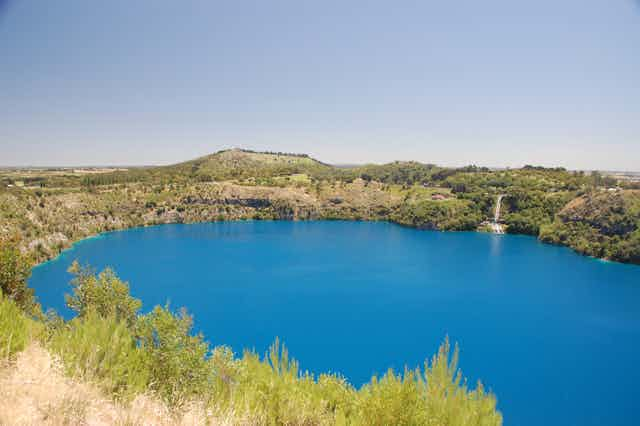Other than it had a fearful shriek, guaranteed to put the fear of God into anyone who heard it, history appears silent about the nature of the bird that Aboriginal Australians once named “bullin”. Yet its shriek portended danger, apparently the approach of the evil spirit Tennateona, but more plausibly an imminent eruption of one of the young volcanoes in the Newer Volcanics Province of southern Australia.
Compared to similar-sized Europe or the continuous US, Australia is remarkably benign volcanically. Volcanism has generally not occurred in Australia since it was first inhabited, perhaps 65,000 years ago, but there are two exceptions. In southern Australia and northern Queensland, volcanic activity likely happened within the past 10,000 years.
More remarkably still, the precise cause(s) of the volcanic activity in these areas remains somewhat elusive. For all that, there is no doubt that volcanic activity occurred here.

Determining its chronology, though, has proved difficult. This is largely because many of its products are undatable, often weathered to the point where no fresh material remains. So ages have generally been determined by proxy, by dating what lavas or ash layers buried, or what lies above them.
Another approach involves interpreting oral stories recorded by Australian Aboriginal peoples as memories of eruptions, from eyewitness accounts of these.
This is similar territory to the demonstrable recollection by Aboriginal peoples of meteorite falls and postglacial sea-level rise that occurred several thousand years ago. It’s a testament to the extraordinary efficacy of transgenerational storytelling in Aboriginal cultures. Such stories can only coarsely bracket the time of eruptions, but supply considerable ancillary detail about what happened before, during and after they occurred.
Further reading: Australia’s volcanic history is a lot more recent than you think
According to one Aboriginal story, the shrieks of the bullin were heard by a person named Craitbul and his family as they wandered through what we now call the Newer Volcanics Province. This is the area of volcanic activity clustered around the southernmost part of the border between South Australia and Victoria.
Settling first on Mount Muirhead, they buried their food overnight in the earth to cook – which tells us the ground here was unusually hot. In the middle of the night, the bullin shrieked, something that can be interpreted as the alarms arising from (unspecified) signs of imminent eruption.
Craitbul’s family fled to Mount Schank, where eventually the same thing happened, so they shifted to Mount Gambier. Here the bullin was silent, but the earth ovens in which they had placed their food flooded – water rose up from below – so they abandoned this area as well.

Many volcanoes of the province (like Gambier) are maars, places where superhot magma (liquid rock) from the Earth’s interior rises until it encounters cold groundwater, whereupon there is an almighty explosion. Rocks are thrown out into the air from a single point on the ground. These often settle in a ring around this point, forming a natural circular basin that invariably fills with rainwater – a maar lake.
Key details of this process are contained in Aboriginal stories of volcanism such as that about Craitbul: the heat below the surface in which food could be cooked; the alarming harbingers of imminent eruption; and the water filling the crater-ovens. Given that the most recent volcanic activity at Gambier and Schank occurred 4,300 years or so ago, this gives us an approximate length of time for the Craitbul story to have endured, largely as an oral tradition.
Recent research has found a remarkable convergence between volcanic eruptions and Aboriginal stories elsewhere in Australia. A compelling study by Ben Cohen and others of the Kinrara Volcano in northern Queensland found that the Gugu Badhun people had stories about when the watercourses in the area caught fire, a recollection of the time perhaps 7,000 years ago when rivers of lava poured down these valleys.
Another Gugu Badhun tale recalls how a witchdoctor made a huge pit in the ground (the crater), a process that filled the air with dust, which made people become disoriented and die. The latter is plausibly a recollection of an ash cloud accompanying the eruption which dispersed toxic gases across a wide area, asphyxiating many of its inhabitants.
Further reading: Ancient Aboriginal stories preserve history of a rise in sea level
Further north, about 40 kilometres south of Cairns on the Atherton Tablelands, we find the maar lakes of Barrine, Eacham and Euramoo. There is an often-told Aboriginal story about at least one of these. One version recalls when two freshly initiated youths broke a taboo and thereby offended the rainbow serpent, Aboriginal Australians’ most powerful and feared supernatural being.

Even though it was the middle of the day, the sky turned blackish-red, and the ground cracked and heaved. Then from it, a liquid spilled out. It engulfed the landscape, leaving a maar lake as a legacy. The ages of deep sediment layers within Lake Eacham suggest the maar eruption that formed it occurred a little over 9,000 years ago.
There are Australian Aboriginal memories of volcanic eruptions that occurred several millennia ago, just as there are numerous memories of coastal drowning that must all be older than 7,000 years, the approximate time at which postglacial drowning came to an end.
Such examples provide a novel way of helping to date natural events in the past and should encourage scientists to treat oral histories and traditions as legitimate sources of scientific information.
Patrick Nunn will give a talk on this subject at Mary Cairncross Theatrette, Maleny, on August 24 at 3pm.

